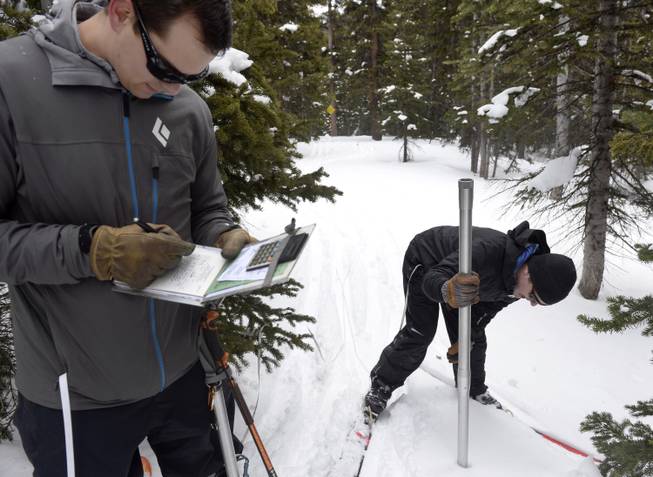
Kathryn Scott Osler / The Denver Post / AP
In this Friday, Jan. 30, 2015, photo on Berthoud Pass near Winter Park, Colo., Brian Domonkos, Colorado Snow Survey supervisor, takes notes while Mike Ardison, a hydrologic technician, takes a measurement of the snow at the Berthoud Summit area.
Wednesday, Feb. 18, 2015 | 3:17 p.m.
DENVER — Snowpack in the mountain valleys where the Colorado River originates was only a little below normal on Wednesday, marking one of the few bright spots in an increasingly grim drought gripping much of the West.
Measurement stations in western Colorado showed the snowpack at 90 percent of the long-term average.
By contrast, reporting stations in the Sierra Nevada range in drought-stricken California showed snowpack at 50 percent or less in early February, the most recent figures available. Some detected no snow at all.
Mountain snow in Colorado is closely monitored because a half-dozen Western waterways, including the 1,400-mile Colorado River, start in the area. The river and its tributaries supply water to millions of people in seven states, including Nevada, and Mexico.
Much of the river comes from mountain snow that accumulates during winter and melts in the spring.
"It's looking pretty dismal over much of the West, but there are some areas where we're OK," said Mike Strobel, manager of the U.S. Department of Agriculture's Snow Survey, which uses about 2,000 reporting stations in the western U.S. and some in Canada to measure snow.
Mountain snow depth usually peaks in early April across the West. However, it's unlikely many of the hardest-hit mountains will get enough precipitation by then to recover, Strobel said.
In the Pacific Northwest, warm temperatures have brought rain instead of snow, so the mountains aren't accumulating snowpack for the spring runoff, when farmers and water managers need water to irrigate crops and refill reservoirs.
Snow accumulation in the Rocky Mountains in Colorado, Wyoming and Montana has been relatively good. Snowpack in the Colorado valleys that feed the east-flowing South Platte River were at 102 percent of average.
"Not spectacular, but not miserable, either," Strobel said.
Even in Colorado, the picture is mixed. Statewide, including the Colorado River, the South Platte and six other basins, the snowpack stands at 78 percent of normal, with the parched southwest corner at 56 percent.
It would take half again the normal amount of snowfall between now and April to bring the statewide snowpack up to average, said Brian Domonkos, who supervises the snow survey in Colorado.
The Colorado River Basin isn't accumulating snow as quickly as it was earlier in the season, Domonkos said Wednesday at a meeting of the state Water Availability Task Force, which monitors drought conditions.
"It's been pretty dry since about the beginning of February," he said.
The Colorado update came after calls for increased multi-state cooperation in the Colorado River basin due to the prolonged drought. The basin is home to 40 million people and 4 million acres of farmland.
Lake Mead in Nevada is the key measuring point of water in the Colorado River system, which also includes the Green, San Juan and Gila rivers and some 55 dams and diversions. The lake dropped to historic levels last year after almost 15 years of regional drought.
Las Vegas, with 2 million residents and 40 million visitors a year, gets 90 percent of its drinking water from Lake Mead. The U.S. Agriculture Department has declared most of Nevada a natural disaster area due to the drought.
Interior Secretary Sally Jewell has called California "ground zero for the drought."

Join the Discussion:
Check this out for a full explanation of our conversion to the LiveFyre commenting system and instructions on how to sign up for an account.
Full comments policy